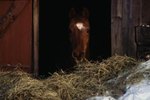Ranching can involve a series of grass types, and finding the ideal pasture grass is often a challenge. Knowing some of the common grass types involved in ranching can ensure the health of a pasture-fed herd and increase the efficiency of a ranching operation. Some grasses are more common than others are, but many can be grazed the same way.
Reed Canary Grass
Reed canary grass grows fast and is easy to find in wetland areas, where it can proliferate easily in the wet soil. Like some other forage crops, reed canary grass can be hard to graze if it gets too tall. The grass becomes more bitter and less inviting to the herd, and livestock tend to only be interested in the leaves of reed canary grass if the crop has overgrown. It is important to graze reed canary grass pastures regularly to avoid this, as it can slow livestock growth. Grazing experts recommend using the pasture as a hay crop if the grass grows too tall.
Bermuda Grass

Bermuda grass is a popular grazing crop because of its dependability and low demand for fertilizer. Bermuda grass is common in the South, and University of Florida foraging expert Glen Burton consider it an excellent crop for achieving high yields, especially in dairy operations. Bermuda grass is also made easily into hay for winter grazing, making it a popular crop for year-round production. Some varieties are much more productive than others, and different types of cattle-raising operations, such as dairy farms, might benefit more from specific varieties.
Fescue

The tallgrass fescue has a reputation as an excellent forage crop. It is often used for grazing in late fall and early winter, and some experts advise against grazing fescue pastures in the growing season because it threatens the crop's ability to survive into the winter. Others caution against using fescue as primary forage as low yields can result. Fescue’s best function is as a part of a varied forage system to help overwinter a livestock herd. The best way to employ fescue is alongside other foraging crops. Some agricultural scientists are working to develop additional summer-dormant varieties of fescue grass.
References
Photo Credits
-
steverts/iStock/Getty Images
Writer Bio
Matt Petryni has been writing since 2007. He was the environmental issues columnist at the "Oregon Daily Emerald" and has experience in environmental and land-use planning. Petryni holds a Bachelor of Science of planning, public policy and management from the University of Oregon.



